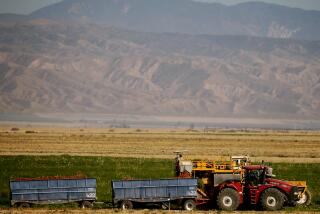Everyone Pays Price for Backroom Water Grab From Farmers
Thanks to the Department of the Interior and the Metropolitan Water District, millions of Southern Californians may soon feel the effect of new water wars in Southern California. In moves eerily reminiscent of Los Angelesâ famous water grab in the Owens Valley a century ago, the Interior Department and the MWD have mixed backroom dealings with water rights and turned their public trust responsibilities upside down.
People deserve the truth about the fight over Colorado River water in the Imperial Valley. On July 3, the Interior Departmentâs Bureau of Reclamation ruled that the Imperial Irrigation District wastes water and therefore should have its water allocation from the Colorado River cut by 9%.
We consider these to be unfair allegations of waste. As important, the court case they stem from shows that they are part of a larger attack on the Imperial Valleyâs water rights -- a new water grab by the largest and most powerful water purveyor in Southern California, the MWD.
First, some background. Last year, the Imperial Irrigation District refused to accept what it considered to be draconian Interior Department cuts in its allocation, cuts meant to trim the overuse of Colorado River water by all of Southern California and, among other things, transfer more water to fast-growing San Diego County, the MWDâs largest water customer. Instead, Imperial proposed its own deal for selling water to San Diego and addressing water conservation, a deal agreeable to San Diego.
But the federal government insisted on its plan and moved to cut our annual allocation by about 300,000 acre-feet, or roughly 10%. We sued and a federal court judge reinstated our water, while giving the Department of the Interior another chance to assess whether or not the valleyâs use of water was âbeneficial.â In the course of the lawsuit, double-dealing by the Interior Department and the MWD has been revealed.
These are the facts. E-mails among Bennett Raley, an assistant secretary at the Department of the Interior, and his lieutenants reveal meetings in November and December between the Interior Department and the MWD, during a time when Imperial thought the MWD was cooperating with it on devising a plan for regional water use. One internal Interior Department note suggests that the water giant might gain access to water that had long been allocated to the Imperial Valley.
The e-mails also indicate that, well in advance of the judgeâs ordering an assessment of Imperialâs âbeneficialâ use, the MWD and the Interior Department were discussing âflawsâ in Imperialâs analysis of its use patterns. In this regard, itâs important to note that once Imperialâs allocation is cut back, the MWD is next in line to receive more Colorado River water.
Finally, the e-mails show the MWDâs desire to keep the state of California, with its strong âpublic interest views,â out of the picture, and they also discuss ways to keep records of the MWD and Interior Departmentâs dealings from being revealed.
In fact, the Interior Department has ruled that the Imperial Irrigation District wastes water. But the irrigation district has a 100-year record of successfully delivering water to farmers in one of the nationâs most productive agricultural areas. At the same time, the district has worked to improve its conservation of agricultural water and help San Diego meet its needs.
Doing this is complicated because the Salton Sea ecosystem relies upon Imperial Valley farm runoff to exist, and cutbacks in our water mean the sea begins to dry up. And Imperialâs water use should not be viewed in isolation. By the MWDâs own account, about 60% of the water delivered to it ends up in the ocean.
So what constitutes âbeneficialâ use? Is it the farmers providing fruits and vegetables for consumers and fiber for the cattle and dairy industries, as well as creating thousands of jobs in the stateâs poorest county? Or is it urban and coastal areas repeatedly failing to implement water conservation and recycling programs and continuing to increase their use?
When the MWD fails to carry out programs aimed at preserving this precious resource, it either raises water prices or makes a grab for somebody elseâs supply, as it is doing in the Imperial Valley, using the Department of the Interior as its misguided enforcer.
Taking water from the Imperial Valley will hit the poorest workers, mainly farm workers, the hardest. It will have an effect on the cost of food across the nation; in winter months, Imperial Valley farmers provide as much as 40% of the nationâs vegetable crops.
Itâs time for the public to send a message to the Department of the Interior, the MWD, Sacramento legislators and Congress that confiscating long-held water rights puts the economy of this region and the state at risk. And that backroom dealing pitting urban and coastal residents against farmers should not be tolerated.
More to Read
Sign up for Essential California
The most important California stories and recommendations in your inbox every morning.
You may occasionally receive promotional content from the Los Angeles Times.










